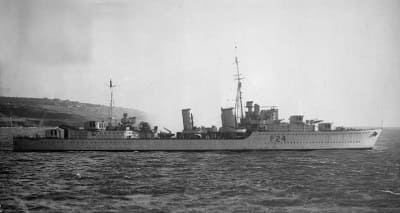Home › Top Destinations Worldwide › Europe › Malta › HMS Maori
Scuba Diving HMS Maori Shipwreck
The history behind the sinking of HMS Maori is one of culture and local pride. In fact, even learner divers can enjoy swimming around the shallowest shipwreck in Malta.
This guide explains everything you need to know about this Tribal-class destroyer and the marine life that shelters inside the ruins - only a few hundred metres from the shores of Valletta.
Why Did British Destroyer HMS Maori Sink?
In the beginning, Fairfield Shipbuilding and Engineering Company built the HMS Maori F24 at a cost of £340,622.
This major warship builder launched the Tribal-class destroyer from the Govan district (Glasgow) on the 2nd of September 1937.
She served alongside United Kingdom Mediterranean Fleet in the early part of World War II.
This is when German aircraft bombed and sunk the HMS Maori at Malta on the 12th of February in 1942.
A single German bomber struck the ship while she was anchored in the Grand Harbour, at Valletta. The missile that entered the engine and gear rooms caused the demise of this famous destroyer.
They actually raised the wreck from the seabed in 1945 before scuttling the vessel away from the coast of Fort St. Elmo on the 15th July.
The Wreck of the HMS Maori F24
For the most part, the bow section is the major attraction for wreck diving enthusiasts to explore. They abandoned the rearmost part of the vessel (aft) in deep water during the scuttling process.
Historical data:
- Length 377 feet (114.9 metres length overall)
- Beam 36 feet 6 inches (11.13 metres)
- Draught 11 feet 3 inches (3.43 metres)
The rusty wreckage of HMS Maori is very popular with novice divers and freedivers because the bow is upright on sand, around sixteen (16) metres below the surface.
You will find the shallow wreck site in a "high-energy" zone near the entrance of Marsamxett Harbour. As a result, winter gales tend to expose this location to the prevailing north-westerly winds.
In addition, a lack of natural topographical shelter means the HMS Maori suffers damage from pollution from the land and destruction from the sea. All of this has resulted in a process of enhanced deterioration.
Fish Life at HMS Maori Shipwreck
Many of the famous dive sites in Malta are boat dives because they rest in deep water. But, this sunken destroyer is easily accessible from the shore, and it's a shallow dive. In fact, the shallowest part is only twelve (12) metres down.
There are many reasons why creating artificial reefs is important, not least for scuba divers to enjoy. Even so, this shallow location offers a unique habitat for an abundance of marine species, including:
- Black-faced blenny
- Common octopus
- Fireworms
- Hermit crabs
- Mediterranean cardinalfish (Apogon Imberbis)
- Mediterranean moray (roman eel)
 Nudibranch
Nudibranch- Parrot fish
- Red mullet
- Salema porgy
- Scorpion fish
- Sea breams
- Stingrays (Myliobatiformes)
- Tube worm annelids
- Wrasses (e.g. thicklip wrasse)
Pro Tip: Our Sea Life creatures and animals guide contains a comprehensive list of vertebrates and invertebrates, including fun and interesting facts, pictures, and videos.
Recommended Scuba Certification Levels
In general, you should not have a problem entering inside large gaps on the wreck. Nonetheless, you should have the Wreck Diver Specialist certification before you start penetrating enclosed spaces.
It's always important to have good buoyancy skills. But, novices will benefit from the Peak Performance Buoyancy training to avoid moving the silt around.
St. Elmo Bay has no shortage of boat traffic, as small motor boats enter and leave the harbour. So, always carry a "safety sausage" and know how to use a DSMB properly. Other useful scuba certifications and dive training might include:
You can read more about the different kinds of PADI certification levels in another section. It also contains a list of distinctive specialties, such as Coral Reef First Aid and Frogfish Specialist Course.
Pro Tip: Beginners should take some time to learn about entanglement hazards underwater and what to do if you find yourself tangled up inside a wreck.
Related Information and Help Guides
- Information about Um El Faroud Wreck Dive in Malta
- Malta Dive Sites: Where's the Best Diving around Malta?
- Where are the Best Locations to Scuba Dive in Europe?
Note: The short video [7:31 seconds] presented by Malta Airport Foundation explains how a tribal class destroyer became a major attraction for scuba divers at the Maltese islands.